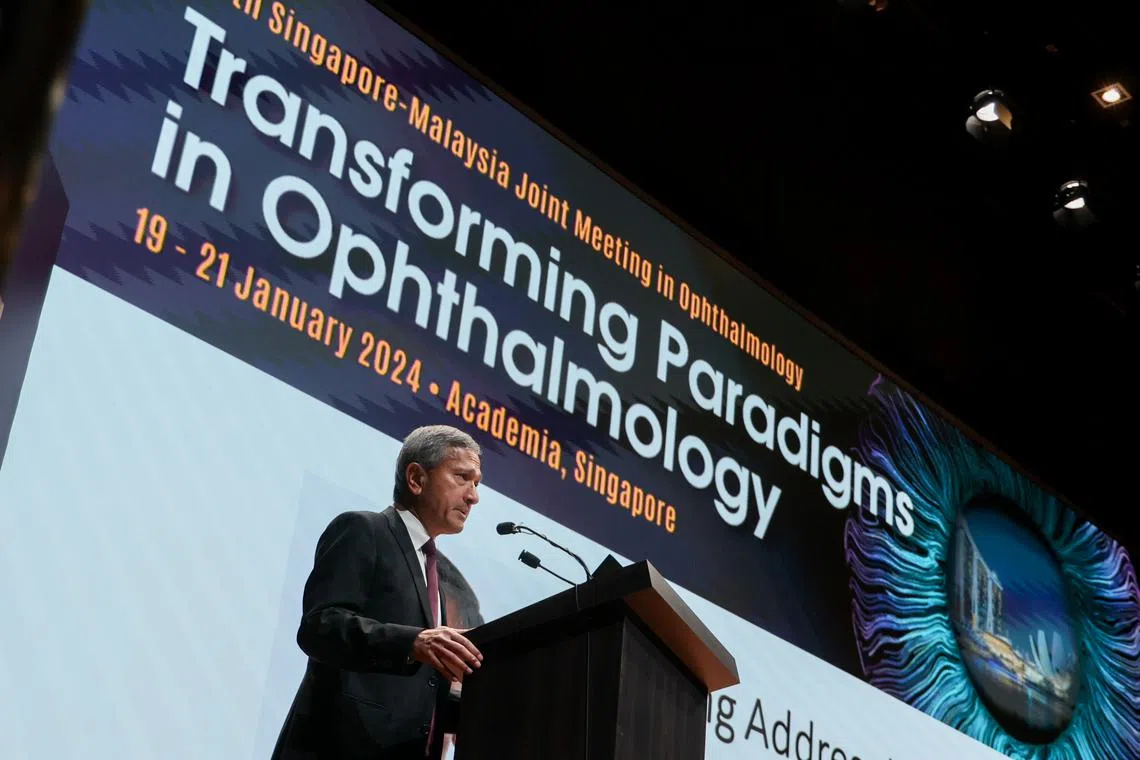Singapore National Eye Centre in tie-up with WHO to address vision impairment in region
Sign up now: Get ST's newsletters delivered to your inbox

Foreign Affairs Minister Vivian Balakrishnan highlighted the importance of investing in research and development and building up institutions.
PHOTO: LIANHE ZAOBAO
Follow topic:
SINGAPORE – As part of its vision to prevent blindness and address sight impairment in the region, the Singapore National Eye Centre (SNEC) is now partnering the World Health Organisation (WHO) in the first collaboration of its kind in South-east Asia.
The tie-up, announced on Jan 20, will see SNEC’s global ophthalmology unit assisting the WHO and countries in providing safe and accessible ophthalmic services.
This makes SNEC a WHO collaborating centre – an institution designated by the WHO director-general to contribute to the organisation’s work. There are over 800 such centres in more than 80 member states, but only a handful deal with vision impairment.
Through this tie-up, SNEC’s global ophthalmology unit will support the growing capacity of the eyecare workforce in the region and provide technical assistance on research work in preventing blindness.
There are about 40 million blind people in the world. South-east Asia has some of the highest rates of blindness, accounting for some 28 per cent of people globally with avoidable blindness, according to WHO figures reported in 2022.
Speaking at the 37th Singapore-Malaysia Joint Meeting in Ophthalmology in the Ngee Ann Kongsi Auditorium at the Singapore General Hospital campus, Foreign Minister Vivian Balakrishnan said: “This is a nice accolade and recognition of how far we’ve come and, more importantly, how much SNEC will contribute to all local and regional standards of ophthalmic care and education.”
Addressing around 600 delegates, Dr Balakrishnan, who was formerly SNEC’s medical director, added: “What I wanted you to think about is to expand this into an Asean network and work together, extend and be more effective in maintaining high standards of education, training and technology dissemination across the entire South-east Asia.”
Highlighting the importance of investing in research and development and building up institutions, he said: “That’s the only way you get progress that builds on itself and lasts the test of time.”
SNEC and the Singapore Eye Research Institute said they have been working with the WHO extensively, including providing expert guidance in the organisation’s think-tank groups and reviewing its policies and guides related to evidence-based eyecare reports.
Speaking to the media on Jan 20, SNEC chief executive Aung Tin said: “There is a high prevalence of blindness and visual impairment in many countries. Singapore is fortunate that we have very good eyecare facilities and are able to help patients manage complex eye diseases.
“Unfortunately, this may not be the case everywhere in the South-east Asia region, and we certainly hope to help in this aspect.”
Professor Aung Tin said one of SNEC’s aims will be to train more ophthalmologists, ophthalmic assistants, technicians and nurses in other countries in the region.
“We have already trained a number of ophthalmologists from Asean countries. Now, with SNEC becoming a WHO collaborating centre, we will help in training even more eyecare professionals under a train-the-trainer scheme, so those who have received training can return to their countries and impart their knowledge to their colleagues.”


